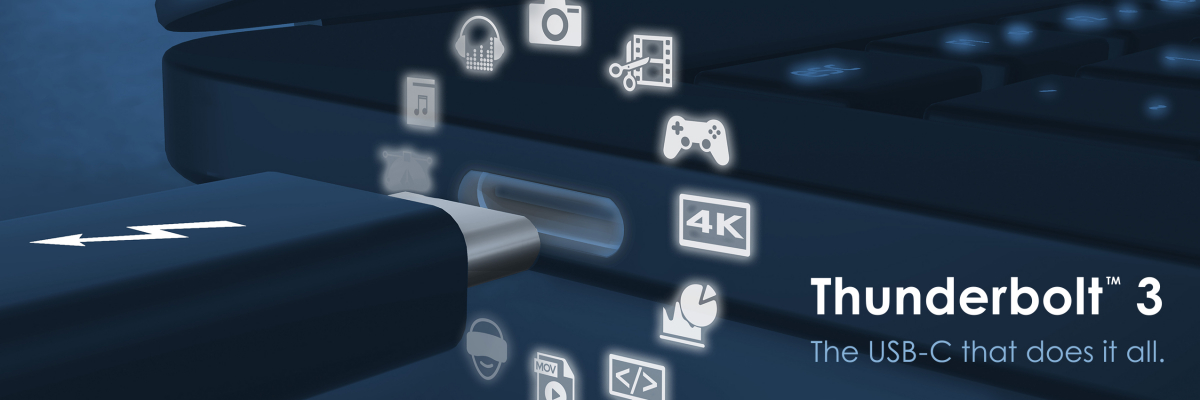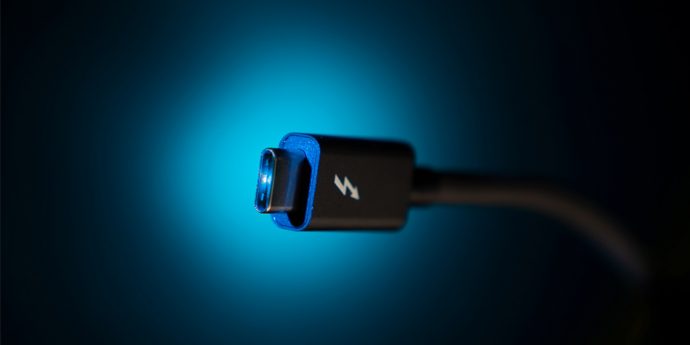Intel Takes Steps to Enable Thunderbolt 3 Everywhere, Releases Protocol
WhatŌĆÖs New: Intel is well on its way to making the inno┬Łva┬Łti┬Łon deli┬Łver┬Łed with Thun┬Łder┬ŁboltŌäó 3 available to ever┬Łyo┬Łne. Today, Intel announ┬Łced that it con┬Łtri┬Łbu┬Łted the Intel Thun┬Łder┬Łbolt pro┬Łto┬Łcol spe┬Łci┬Łfi┬Łca┬Łti┬Łon to the USB Pro┬Łmo┬Łter Group, enab┬Łling other chip makers to build Thun┬Łder┬Łbolt com┬Łpa┬Łti┬Łble sili┬Łcon, royal┬Łty-free. In addi┬Łti┬Łon, the USB Pro┬Łmo┬Łter Group announ┬Łced the pen┬Łding release of the USB4 spe┬Łci┬Łfi┬Łca┬Łti┬Łon, based on the Thun┬Łder┬Łbolt pro┬Łto┬Łcol. The con┬Łver┬Łgence of the under┬Łly┬Łing Thun┬Łder┬Łbolt and USB pro┬Łto┬Łcols will increase com┬Łpa┬Łti┬Łbi┬Łli┬Łty among USB TypeŌĆæC con┬Łnec┬Łtor-based pro┬Łducts, sim┬Łpli┬Łfy┬Łing how peo┬Łp┬Łle con┬Łnect their devices.
ŌĆ£Releasing the Thun┬Łder┬Łbolt pro┬Łto┬Łcol spe┬Łci┬Łfi┬Łca┬Łti┬Łon is a signi┬Łfi┬Łcant mile┬Łstone for making todayŌĆÖs simp┬Łlest and most ver┬Łsa┬Łti┬Łle port available to ever┬Łyo┬Łne. This, in com┬Łbi┬Łna┬Łti┬Łon with the inte┬Łgra┬Łti┬Łon of Thun┬Łder┬Łbolt 3 into upco┬Łming Intel pro┬Łces┬Łsors is a win-win for the indus┬Łtry and consumers.ŌĆØ
ŌĆōJason Zil┬Łler, gene┬Łral mana┬Łger, Cli┬Łent Con┬Łnec┬Łti┬Łvi┬Łty Divi┬Łsi┬Łon at Intel
Why It Mat┬Łters: Pre┬Łvious┬Łly, Intel shared plans to inte┬Łgra┬Łte Thun┬Łder┬Łbolt 3 into future Intel CPUs and to release the Thun┬Łder┬Łbolt pro┬Łto┬Łcol spe┬Łci┬Łfi┬Łca┬Łti┬Łon to the indus┬Łtry. As detail┬Łed at CES 2019, IntelŌĆÖs upco┬Łming 10nm pro┬Łces┬Łsor code-named ŌĆ£Ice LakeŌĆØ will be the first to inte┬Łgra┬Łte Thun┬Łder┬Łbolt 3. Pro┬Łces┬Łsor inte┬Łgra┬Łti┬Łon, com┬Łbi┬Łned with todayŌĆÖs announce┬Łment, is expec┬Łted to dri┬Łve lar┬Łge-sca┬Łle, main┬Łstream adop┬Łti┬Łon of Thunderbolt.
Indus┬Łtry adop┬Łti┬Łon of Thun┬Łder┬Łbolt 3 is acce┬Łle┬Łra┬Łting. Thun┬Łder┬Łbolt 3 is ful┬Łly sup┬Łport┬Łed in Win┬Łdows 10*, macOS* and Linux*; volu┬Łmes of PCs with the┬Łse ports con┬Łti┬Łnue to dou┬Łble every year into the tens of mil┬Łli┬Łons; and all the latest Macs* have Thun┬Łder┬Łbolt 3 ports. More than 400 PC designs have been enab┬Łled with Thun┬Łder┬Łbolt 3. Peri┬Łphe┬Łral device volu┬Łmes also con┬Łti┬Łnue to dou┬Łble annu┬Łal┬Łly with more than 450 cer┬Łti┬Łfied devices from a wide num┬Łber of pro┬Łduct cate┬Łgo┬Łries, inclu┬Łding docks, dis┬Łplays, sto┬Łrage and exter┬Łnal graphics.
ŌĆ£Rea┬Łli┬Łzing HPŌĆÖs visi┬Łon for the office of the future requi┬Łres seam┬Łless con┬Łnec┬Łti┬Łvi┬Łty, powerful per┬Łfor┬Łmance and total sim┬Łpli┬Łci┬Łty to enable peo┬Łp┬Łle to unleash their crea┬Łti┬Łvi┬Łty whe┬Łre┬Łver their work┬Łday takes them,ŌĆØ said Bill Gor┬Łden, vice pre┬Łsi┬Łdent, Com┬Łmer┬Łcial Note┬Łbook Manage┬Łment at HP. ŌĆ£Thun┬Łder┬Łbolt 3 is a powerful addi┬Łti┬Łon to our new note┬Łbooks and docks that deli┬Łvers the fle┬Łxi┬Łbi┬Łli┬Łty sought by IT depart┬Łments and the expe┬Łri┬Łen┬Łces peo┬Łp┬Łle love.ŌĆØ
ŌĆ£Sam┬Łsung Elec┬Łtro┬Łnics is respon┬Łding to incre┬Łasing con┬Łsu┬Łmer demand for Thun┬Łder┬Łbolt 3 by offe┬Łring sleek and powerful note┬Łbooks and other peri┬Łphe┬Łral devices,ŌĆØ said Min┬Łcheol Lee, vice pre┬Łsi┬Łdent, PC Stra┬Łte┬Łgic Mar┬Łke┬Łting at Sam┬Łsung Elec┬Łtro┬Łnics. ŌĆ£We look for┬Łward to our ongo┬Łing col┬Łla┬Łbo┬Łra┬Łti┬Łon with Intel to bring more inno┬Łva┬Łti┬Łve Thun┬Łder┬Łbolt 3 pro┬Łducts to market.ŌĆØ
How Thun┬Łder┬Łbolt Leads with Best-in-Class Solu┬Łti┬Łons: Thun┬Łder┬Łbolt deli┬Łvers world-class per┬Łfor┬Łmance, ease-of-use and qua┬Łli┬Łty by uni┬Łfy┬Łing mul┬Łti┬Łple indus┬Łtry spe┬Łci┬Łfi┬Łca┬Łti┬Łons into an indus┬Łtry lea┬Łding set of pro┬Łduct capa┬Łbi┬Łli┬Łties. Thun┬Łder┬Łbolt is sup┬Łport┬Łed by an end-to-end solu┬Łti┬Łon enab┬Łling pro┬Łgram for com┬Łpu┬Łter, peri┬Łphe┬Łral device and cable makers to help ensu┬Łre a con┬Łsis┬Łtent expe┬Łri┬Łence for all Thun┬Łder┬Łbolt con┬Łnec┬Łted pro┬Łducts. Intel works with the indus┬Łtry to defi┬Łne pro┬Łduct capa┬Łbi┬Łli┬Łties, vali┬Łda┬Łti┬Łon test┬Łing and rigo┬Łrous cer┬Łti┬Łfi┬Łca┬Łti┬Łon requi┬Łre┬Łments, including:
- Working clo┬Łse┬Łly with Micro┬Łsoft* to deli┬Łver built-in Win┬Łdows 10 sup┬Łport for Thun┬Łder┬Łbolt 3, opti┬Łmi┬Łzed for plug and play, plat┬Łform power manage┬Łment, sys┬Łtem char┬Łging and sys┬Łtem wake features
- Intel CPU plat┬Łform and peri┬Łphe┬Łral refe┬Łrence design validation
- Exten┬Łsi┬Łve end-to-end test┬Łing to help ensu┬Łre inter┬Łope┬Łra┬Łbi┬Łli┬Łty across a wide ran┬Łge of pro┬Łduct types and manufacturers
- Man┬Łda┬Łto┬Łry Thun┬Łder┬Łbolt cer┬Łti┬Łfi┬Łca┬Łti┬Łon for all com┬Łpu┬Łters, peri┬Łphe┬Łral devices and cables
- Cable enab┬Łling and cable qua┬Łli┬Łty audits for Thun┬Łder┬Łbolt cable manufacturers
Intel and other indus┬Łtry lea┬Łders con┬Łti┬Łnue to inno┬Łva┬Łte on Thun┬Łder┬Łbolt tech┬Łno┬Łlo┬Łgy to deli┬Łver a lea┬Łding con┬Łnec┬Łti┬Łvi┬Łty solu┬Łti┬Łon, from sili┬Łcon and cables to PCs and peri┬Łphe┬Łral devices.
More Con┬Łtext: Thun┬Łder┬Łbolt and Thun┬Łder┬Łbolt cer┬Łti┬Łfied products
About Intel
Intel (NASDAQ: INTC), a lea┬Łder in the semi┬Łcon┬Łduc┬Łtor indus┬Łtry, is sha┬Łping the data-cen┬Łtric future with com┬Łpu┬Łting and com┬Łmu┬Łni┬Łca┬Łti┬Łons tech┬Łno┬Łlo┬Łgy that is the foun┬Łda┬Łti┬Łon of the worldŌĆÖs inno┬Łva┬Łtions. The companyŌĆÖs engi┬Łnee┬Łring exper┬Łti┬Łse is hel┬Łping address the worldŌĆÖs grea┬Łtest chal┬Łlenges as well as hel┬Łping secu┬Łre, power and con┬Łnect bil┬Łli┬Łons of devices and the infra┬Łstruc┬Łtu┬Łre of the smart, con┬Łnec┬Łted world ŌĆō from the cloud to the net┬Łwork to the edge and ever┬Ły┬Łthing in bet┬Łween. Find more infor┬Łma┬Łti┬Łon about Intel at newsroom.intel.com and intel.com.
Intel and the Intel logo are trade┬Łmarks of Intel Cor┬Łpo┬Łra┬Łti┬Łon in the United Sta┬Łtes and other countries.
*Other names and brands may be clai┬Łmed as the pro┬Łper┬Łty of others.


